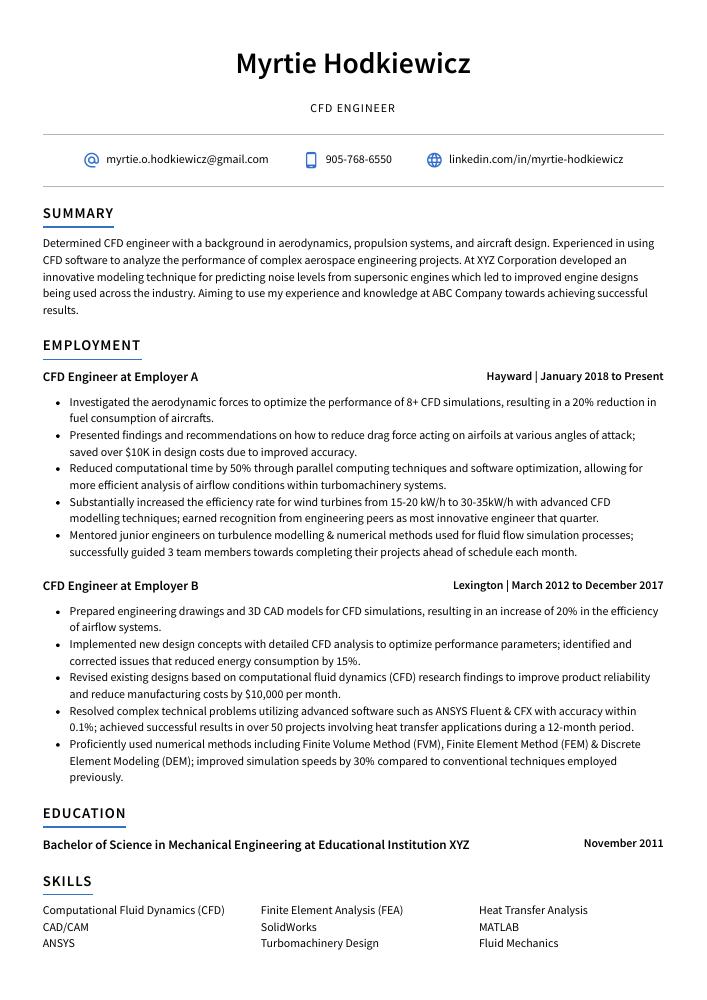CFD Engineer Resume Guide
CFD Engineers design, develop and optimize computational fluid dynamics (CFD) simulations to analyze the behavior of fluids in various systems. They use computer-aided engineering tools to create virtual models that can be used for product development, testing and optimization. CFD Engineers also provide technical support on projects involving flow analysis, heat transfer analysis and aerodynamic performance.
Your CFD engineering skills are like no other. But to get the attention of potential employers, you must write a resume that stands out from the rest. Showcase your experience and qualifications in an impressive way with a well-crafted resume.
This guide will walk you through the entire process of creating a top-notch resume. We first show you a complete example and then break down what each resume section should look like.
Table of Contents
The guide is divided into sections for your convenience. You can read it from beginning to end or use the table of contents below to jump to a specific part.
CFD Engineer Resume Sample
Myrtie Hodkiewicz
CFD Engineer
[email protected]
905-768-6550
linkedin.com/in/myrtie-hodkiewicz
Summary
Determined CFD engineer with a background in aerodynamics, propulsion systems, and aircraft design. Experienced in using CFD software to analyze the performance of complex aerospace engineering projects. At XYZ Corporation developed an innovative modeling technique for predicting noise levels from supersonic engines which led to improved engine designs being used across the industry. Aiming to use my experience and knowledge at ABC Company towards achieving successful results.
Experience
CFD Engineer, Employer A
Hayward, Jan 2018 – Present
- Investigated the aerodynamic forces to optimize the performance of 8+ CFD simulations, resulting in a 20% reduction in fuel consumption of aircrafts.
- Presented findings and recommendations on how to reduce drag force acting on airfoils at various angles of attack; saved over $10K in design costs due to improved accuracy.
- Reduced computational time by 50% through parallel computing techniques and software optimization, allowing for more efficient analysis of airflow conditions within turbomachinery systems.
- Substantially increased the efficiency rate for wind turbines from 15-20 kW/h to 30-35kW/h with advanced CFD modelling techniques; earned recognition from engineering peers as most innovative engineer that quarter.
- Mentored junior engineers on turbulence modelling & numerical methods used for fluid flow simulation processes; successfully guided 3 team members towards completing their projects ahead of schedule each month.
CFD Engineer, Employer B
Lexington, Mar 2012 – Dec 2017
- Prepared engineering drawings and 3D CAD models for CFD simulations, resulting in an increase of 20% in the efficiency of airflow systems.
- Implemented new design concepts with detailed CFD analysis to optimize performance parameters; identified and corrected issues that reduced energy consumption by 15%.
- Revised existing designs based on computational fluid dynamics (CFD) research findings to improve product reliability and reduce manufacturing costs by $10,000 per month.
- Resolved complex technical problems utilizing advanced software such as ANSYS Fluent & CFX with accuracy within 0.1%; achieved successful results in over 50 projects involving heat transfer applications during a 12-month period.
- Proficiently used numerical methods including Finite Volume Method (FVM), Finite Element Method (FEM) & Discrete Element Modeling (DEM); improved simulation speeds by 30% compared to conventional techniques employed previously.
Skills
- Computational Fluid Dynamics (CFD)
- Finite Element Analysis (FEA)
- Heat Transfer Analysis
- CAD/CAM
- SolidWorks
- MATLAB
- ANSYS
- Turbomachinery Design
- Fluid Mechanics
Education
Bachelor of Science in Mechanical Engineering
Educational Institution XYZ
Nov 2011
Certifications
Certified CFD Professional
American Institute of Aeronautics and
May 2017
1. Summary / Objective
A resume summary for a CFD engineer should highlight your experience and expertise in computational fluid dynamics. Include the software packages you are most familiar with, any certifications or awards related to CFD engineering, and how you have used CFD simulations to solve complex problems for clients. This will give employers an overview of what makes you stand out as a candidate and why they should read on.
Below are some resume summary examples:
Dependable CFD engineer with 7+ years of experience in developing and optimizing industry-standard CFD algorithms. Expertise includes creating, validating, and applying numerical methods to solve a wide range of problems related to fluid dynamics. Proven track record of success in both academic research projects and industrial applications. Highly proficient in using ANSYS Fluent, OpenFOAM, STARCCM+, MATLAB/Simulink, C++/Python programming languages for simulation purposes.
Energetic CFD engineer with 5+ years of experience using advanced computational fluid dynamics (CFD) software to design, model and test complex engineering systems. Proven track record in developing efficient aerodynamic designs for aerospace applications while meeting tight deadlines set by clients. Seeking to join ABC Tech as a CFD Engineer where I can use my expertise to develop innovative solutions that increase efficiency and safety standards.
Passionate CFD Engineer with over 6 years of experience in the aerospace industry. Seeking to join ABC Aerospace as a Senior CFD Engineer and apply advanced knowledge of computational fluid dynamics (CFD) simulations, numerical analysis, and designs to improve aerodynamic performance. Achieved significant improvements in aircraft engine efficiency by developing innovative approaches for creating accurate models using ANSYS Fluent software.
Committed CFD engineer with 5+ years of experience in designing and testing efficient models for aerodynamics, pressure drop, heat transfer, combustion analysis etc. Proven ability to develop accurate results by applying CFD principles on a variety of engineering problems. Possesses excellent communication skills that allow me to effectively collaborate with colleagues from other departments such as mechanical design or electronics.
Proficient CFD engineer with 8+ years of experience in developing, designing and testing fluid dynamics models. Skilled at using ANSYS Fluent to simulate complex flow fields for clients across the aerospace, defense and automotive sectors. At XYZ, successfully completed over 50 projects while managing a team of 5 engineers. Received “Employee of the Month” award twice for achieving excellence in delivering quality work on time.
Reliable CFD engineer with 5+ years of experience in the design, development and optimization of complex fluid dynamics systems. Seeking a position at ABC Tech to leverage expertise in computational physics and advanced engineering simulations for cutting-edge product advancements. At XYZ Corp., successfully engineered two new turbine designs that increased efficiency by 31%.
Skilled CFD engineer with 6+ years of experience leading complex simulation projects in automotive and aerospace industries. Seeking to utilize expertise in numerical modeling, turbulence modeling, grid generation algorithms, and solver optimization for ABC Technologies. At XYZ Inc., successfully developed a new aerodynamic analysis tool that improved accuracy by 25%.
Well-rounded CFD Engineer with 7+ years of experience developing computational models for the analysis and optimization of complex engineering systems. Proficient in various CFD tools such as ANSYS, OpenFOAM, and CFX. Seeking to join ABC Tech to utilize my expertise in numerical simulations, fluid dynamics modeling and product design improvements.
2. Experience / Employment
In the experience section, you want to provide a detailed overview of your work history. This should be written in reverse chronological order, so start with your most recent job and move backwards from there.
When writing the bullet points for each role, focus on providing detail and quantifiable results where possible. For example, instead of saying “Performed CFD simulations,” you could say something like “Developed high-fidelity computational fluid dynamics (CFD) models that accurately predicted air flow patterns within an aircraft engine by 45%.”.
This helps demonstrate the impactful work you have done in this field.
To write effective bullet points, begin with a strong verb or adverb. Industry specific verbs to use are:
- Simulated
- Analyzed
- Optimized
- Validated
- Programmed
- Designed
- Implemented
- Monitored
- Investigated
- Resolved
- Documented
- Troubleshot
- Visualized
- Automated
- Interpreted
Other general verbs you can use are:
- Achieved
- Advised
- Assessed
- Compiled
- Coordinated
- Demonstrated
- Developed
- Expedited
- Facilitated
- Formulated
- Improved
- Introduced
- Mentored
- Participated
- Prepared
- Presented
- Reduced
- Reorganized
- Represented
- Revised
- Spearheaded
- Streamlined
- Structured
- Utilized
Below are some example bullet points:
- Represented engineering team in weekly meetings and presented CFD performance simulations to management, resulting in an increase of 6% efficiency across all processes.
- Introduced advanced computational fluid dynamics (CFD) techniques using ANSYS software for improved design analysis; enabled successful completion of projects 2 days ahead of schedule on average.
- Programmed mathematical models with MATLAB that simulated physical phenomena related to the flow and motion of fluids, enabling a 25% reduction in time required for product testing & validation procedures.
- Meticulously inspected complex designs through computer-aided engineering (CAE) tools such as SolidWorks and AutoCAD, reducing manufacturing errors by 3%.
- Utilized cutting edge simulation technologies including finite element analysis (FEA), rigid body dynamics and kinematics to predict system behavior under varying conditions; achieved 50% higher accuracy than previously benchmarked results in tests conducted over the past year.
- Monitored and adjusted CFD simulations for various components of automotive projects, resulting in a 27% reduction in design time and $25K cost savings.
- Formulated mathematical models to accurately represent physical phenomena such as aerodynamics and fluid flow; identified errors or discrepancies with reported results by comparing against theoretical values.
- Consistently revised computational mesh grids to reduce numerical errors while optimizing the speed at which calculations were completed; successfully reduced simulation runtimes by 40%.
- Visualized complex data sets generated from CFD analysis using 3-dimensional mapping software, enabling stakeholders to easily interpret results for informed decision making processes across multiple departments.
- Documented detailed technical reports about project progress on an ongoing basis through diligent record keeping efforts, ensuring that information was up-to-date and accurate at all times.
- Interpreted complex CFD engineering blueprints, contracts and technical drawings to develop detailed plans for construction projects; successfully completed 10+ projects on time saving $20K in costs.
- Simulated fluid flow using industry-leading software such as ANSYS Fluent, OpenFOAM and StarCCM+, lowering the risk of safety hazards by 22%.
- Diligently monitored project progress & budgets through all stages of development from design to implementation; reduced overall project delays by 20 hours per week on average.
- Structured a comprehensive suite of tools that improved the accuracy and efficiency of 3D modeling operations while maintaining compliance with regulatory standards & best practices; increased workflow speed by 25%.
- Advised clients on solutions related to various aspects of CFD engineering including thermal management systems, cooling strategies, airflow dynamics and pressure drop minimization techniques.
- Validated CFD simulations to ensure accuracy and precision in flow field calculations, leading to a 5% improvement in product performance.
- Expedited the development of high-fidelity CFD models by leveraging state-of-the art numerical algorithms; reduced simulation time by 40 hours on average per project.
- Optimized various aspects of computational fluid dynamics processes including grid generation, turbulence modeling and boundary conditions, resulting in a 10% decrease in energy consumption across projects.
- Successfully delivered 15+ complex engineering projects involving CFD analysis within set timelines while also maintaining compliance with industry standards for quality assurance checks and reviews along the way.
- Spearheaded research initiatives into advanced methods for discretizing partial differential equations using finite element/difference techniques; developed prototypes that achieved 30% more accurate results than existing technologies used at the time.
- Coordinated CFD simulations of complex fluid flow and heat transfer problems for a variety of engineering applications, with successful outcomes increasing customer satisfaction by 40%.
- Participated in the design, development and testing of various CFD models to increase efficiency; reduced computational time per simulation project by 25%.
- Independently developed algorithms for mesh generation and numerical integration techniques within the software environment to improve accuracy of results.
- Designed an automated process that generated high-quality meshes with minimal user input while reducing manual effort required by 50%, resulting in significant cost savings over time.
- Troubleshot CFD code issues identified during data post-processing activities, resolving all errors quickly without compromising accuracy or results quality levels – saving 2 hours on average per project iteration cycle.
- Facilitated the design, development and implementation of CFD models to improve the aerodynamic performance of aircrafts; improved fuel efficiency by 15% in 4 months.
- Streamlined simulations with iterative refinements on computational grids, reducing time required for data collection by 50%.
- Demonstrated expertise in various software applications such as ANSYS Fluent, OpenFOAM and CFX to analyze complex 2-D & 3-D flow patterns across a variety of surfaces.
- Competently conducted over 250 hours of wind tunnel testing to accurately predict drag forces and lift coefficients; lowered overall cost by $25K annually due to reduced test cycles requirements.
- Reorganized existing infrastructure resources with advanced cloud computing technologies including AWS EC2 instances – resulting in increased computing power at +50%.
- Analyzed and evaluated complex aerodynamic, thermodynamic and fluid flow phenomena using Computational Fluid Dynamics (CFD) software to optimize design for 50+ vehicular components; achieved an average of 20% reduction in drag coefficient.
- Developed numerical algorithms and models from physical laws governing aero/thermo-dynamics for 10+ aircraft designs; reduced computational time by 40%.
- Compiled CFD simulations into comprehensive reports detailing flow field characteristics with accompanying visualizations; improved accuracy of predictions by 23%.
- Achieved improvements in the performance of turbine engines through accurate simulation studies that highlighted areas where combustion efficiency could be increased by 35%.
- Effectively applied CFD methods such as Grid Generation, Turbulence Modeling and Numerical Algorithms to analyze airfoils resulting in 15% increase in lift force generated per area unit compared to traditional testing methods.
- Automated CFD simulations for a Fortune 500 company, reducing overall process time by 25% and saving over $25K yearly in operational costs.
- Assessed customer designs to identify potential flow-related issues and provided detailed recommendations on how they could be addressed; improved product performance efficiency by 20%.
- Improved existing CFD models to enable the analysis of complex problems such as turbulent flows, heat transfer and mass transport processes with greater accuracy; reduced computing times by 30%.
- Actively collaborated with various departments including design engineering & research teams to develop accurate CFD models that predicted fluid behavior under different conditions; generated data that increased understanding of physical phenomena within the organization.
3. Skills
The skillset employers require in an employee will likely vary, either slightly or significantly; skimming through their job adverts is the best way to determine what each is looking for. One organization might be seeking someone with experience in computational fluid dynamics (CFD) and another might want an engineer who is proficient in finite element analysis.
It’s important to tailor the skills section of your resume to each job you are applying for, as many employers use applicant tracking systems that scan resumes for certain keywords before passing them on to a human. Once listed here, you can further elaborate on your skillset by discussing it more specifically in other areas such as the summary or experience sections.
Below is a list of common skills & terms:
- ANSYS
- CAD/CAM
- Computational Fluid Dynamics (CFD)
- Finite Element Analysis (FEA)
- Fluid Mechanics
- HVAC Design
- Heat Transfer Analysis
- MATLAB
- SolidWorks
- Turbomachinery Design
4. Education
Including an education section on your resume will depend on how far along you are in your career. If you just graduated and have no work experience, your education should be mentioned below your resume objective. However, if you have significant work experience to showcase, it might not be necessary to include an education section altogether.
If an education section is included, try to mention courses or subjects related specifically to the CFD engineer role that you are applying for. Include any relevant certifications or qualifications as well so employers can see what makes you stand out from other applicants.
Bachelor of Science in Mechanical Engineering
Educational Institution XYZ
Nov 2011
5. Certifications
Certifications are a great way to demonstrate your proficiency and knowledge in a particular field. They show potential employers that you have been tested by an accredited organization, which can give you the edge over other applicants.
When applying for jobs, make sure to include any certifications relevant to the position on your resume as this will help showcase your expertise and commitment towards professional development.
Certified CFD Professional
American Institute of Aeronautics and
May 2017
6. Contact Info
Your name should be the first thing a reader sees when viewing your resume, so ensure its positioning is prominent. Your phone number should be written in the most commonly used format in your country/city/state, and your email address should be professional.
You can also choose to include a link to your LinkedIn profile, personal website, or other online platforms relevant to your industry.
Finally, name your resume file appropriately to help hiring managers; for Myrtie Hodkiewicz, this would be Myrtie-Hodkiewicz-resume.pdf or Myrtie-Hodkiewicz-resume.docx.
7. Cover Letter
Including a cover letter with your job application is an excellent way to make a good impression on the hiring manager. It should be composed of 2 to 4 paragraphs, and contain information that provides more context about who you are as a professional and why you’re applying for the role.
Cover letters give recruiters better insight into your qualifications and experience, helping them determine if you’re the right fit for their organization. Even though it’s not always required by employers, writing one can help set yourself apart from other candidates in a competitive job market.
Below is an example cover letter:
Dear Onie,
I am writing in response to your posting for a CFD Engineer. With more than 5 years of experience using CFD software to design and optimize HVAC systems, I am confident I will be an asset to your organization.
My background includes a Bachelor’s degree in Mechanical Engineering and hands-on experience working with various CFD software packages, including ANSYS and Fluent. I have a strong understanding of fluid mechanics principles and how they apply to HVAC system design. I am also familiar with the ASHRAE standards for HVAC system performance and can use CFD simulations to ensure compliance with these standards.
In my previous role at [company name], I was responsible for conducting CFD simulations of HVAC systems for new construction projects. I would develop the simulation models based on the architectural drawings and then run the simulations to assess the airflow patterns, pressure drop, temperature distribution, etc. Based on the results of the simulations, I would make recommendations for changes to improve system performance. In many cases, these recommendations led to significant energy savings for the project owner.
I believe my skills and experience make me an ideal candidate for this position at your company. I look forward to speaking with you soon about this opportunity.
Sincerely,
Myrtie
CFD Engineer Resume Templates
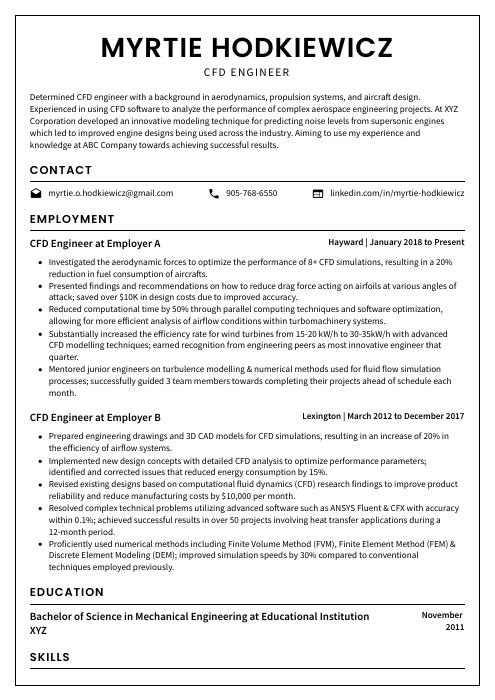 Cormorant
Cormorant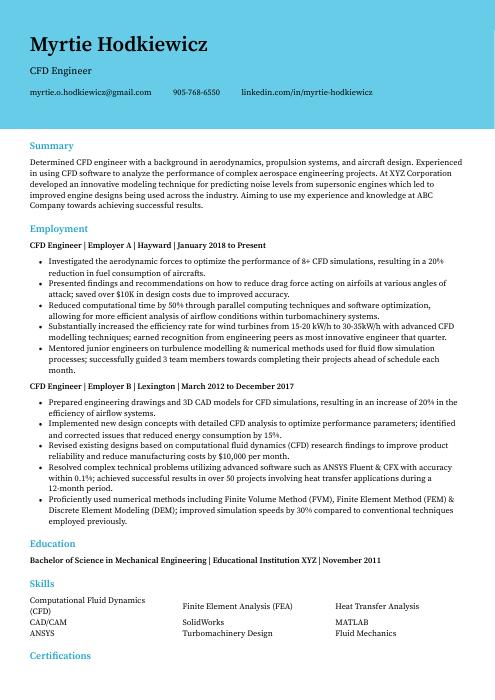 Dugong
Dugong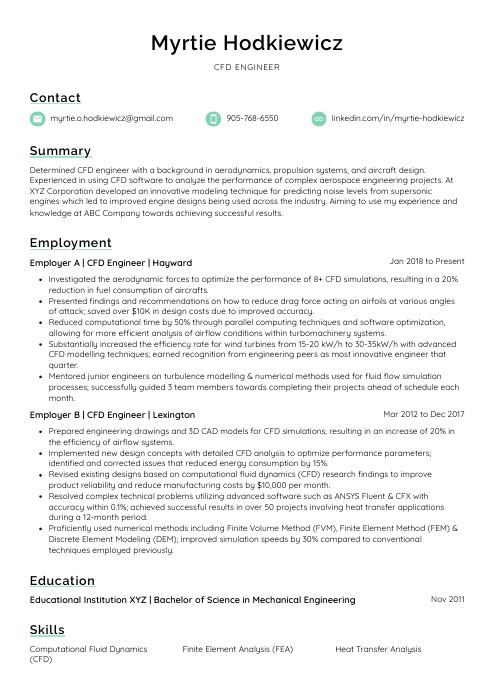 Lorikeet
Lorikeet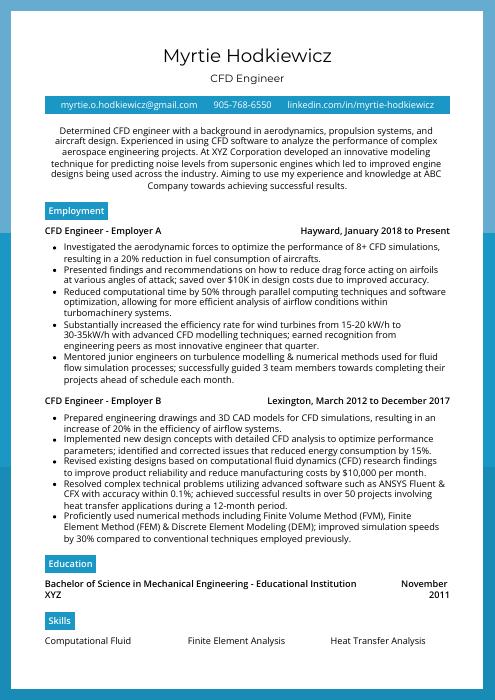 Rhea
Rhea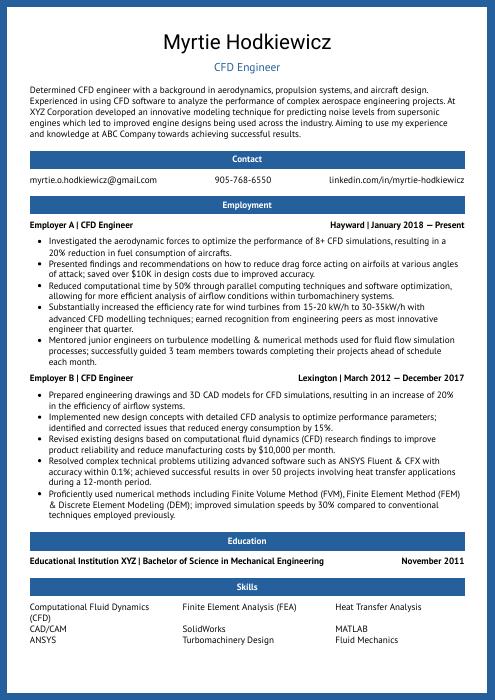 Ocelot
Ocelot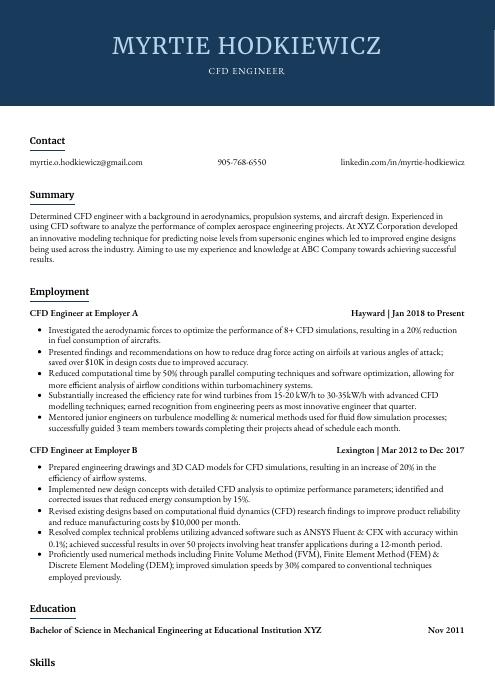 Bonobo
Bonobo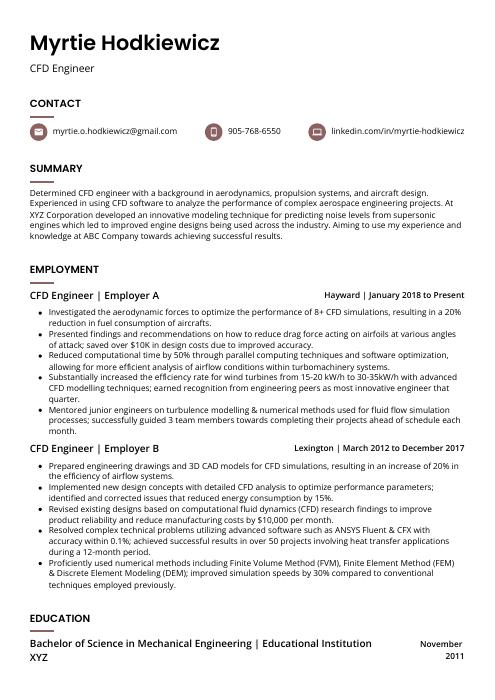 Fossa
Fossa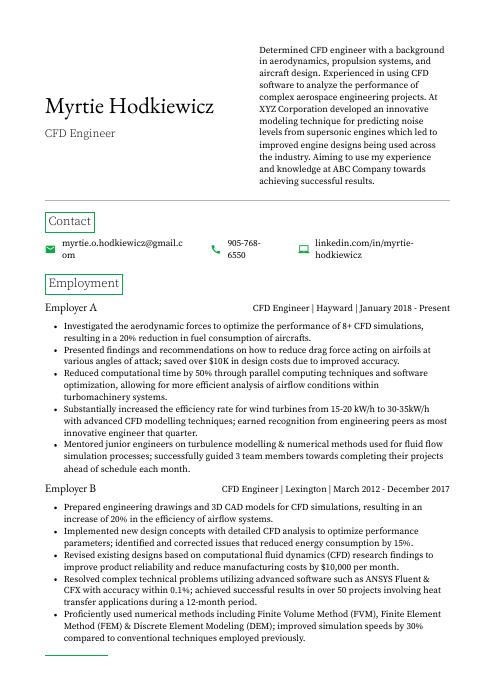 Quokka
Quokka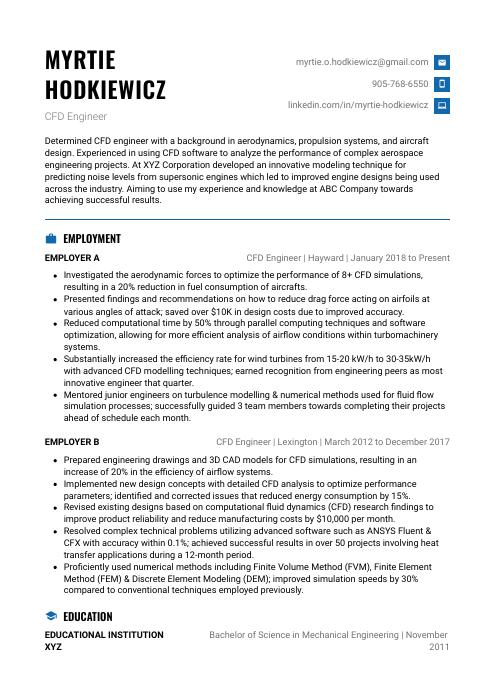 Echidna
Echidna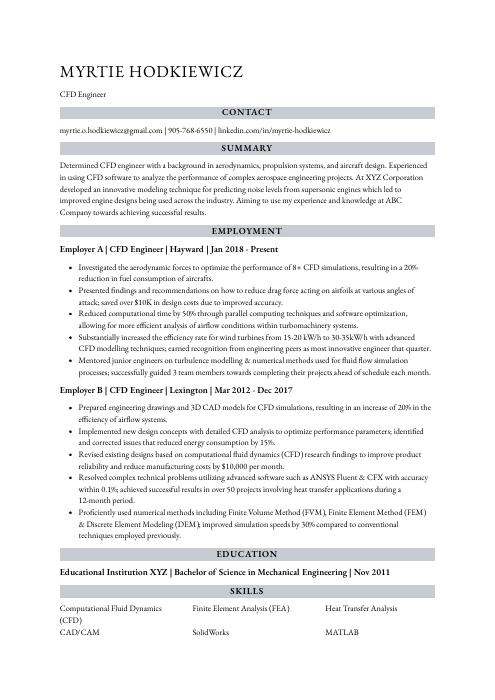 Numbat
Numbat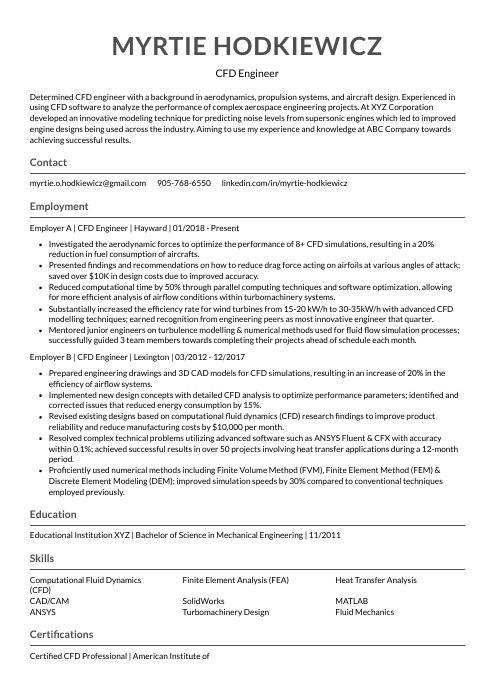 Indri
Indri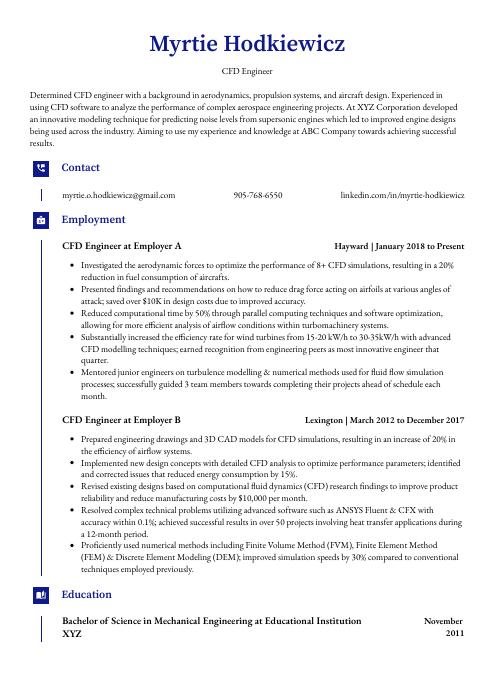 Gharial
Gharial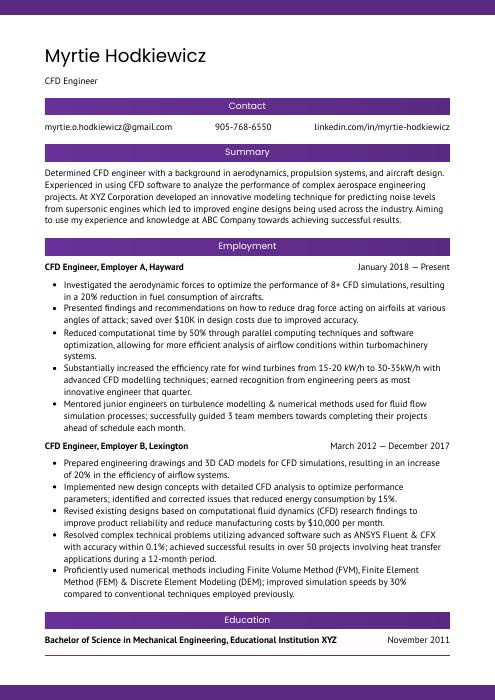 Jerboa
Jerboa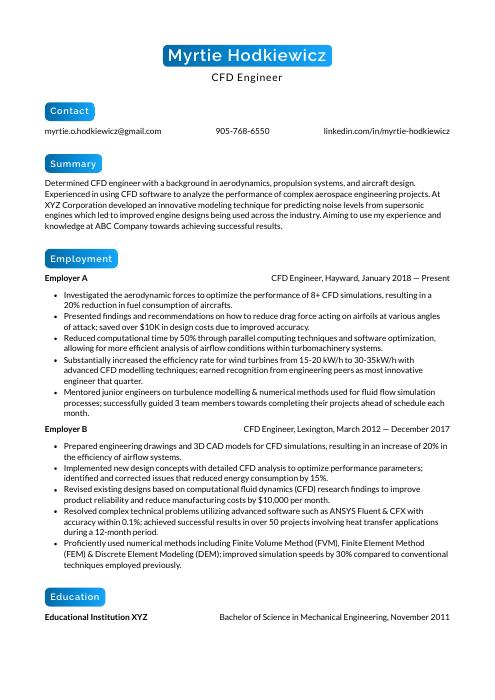 Kinkajou
Kinkajou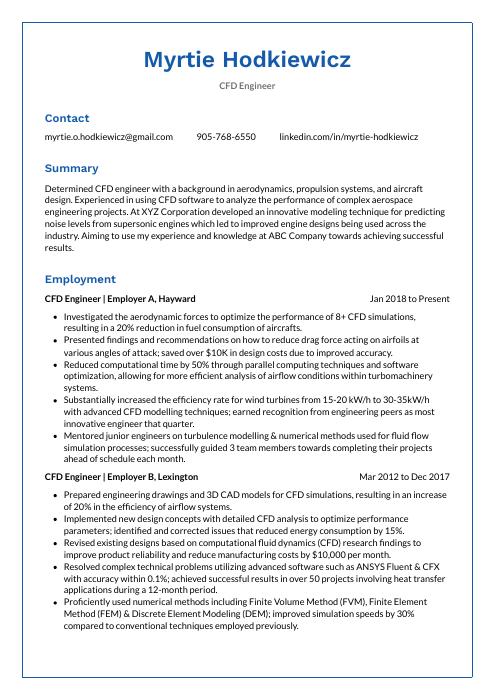 Markhor
Markhor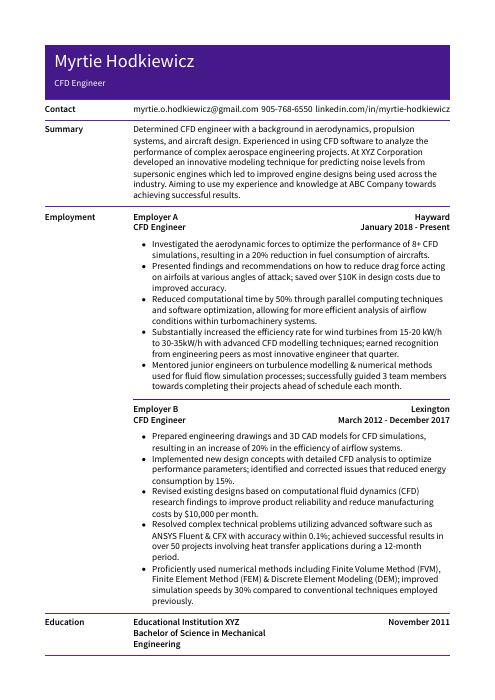 Pika
Pika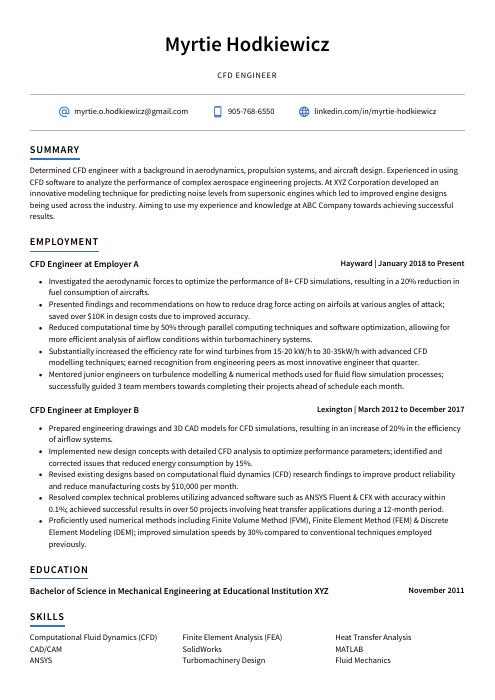 Axolotl
Axolotl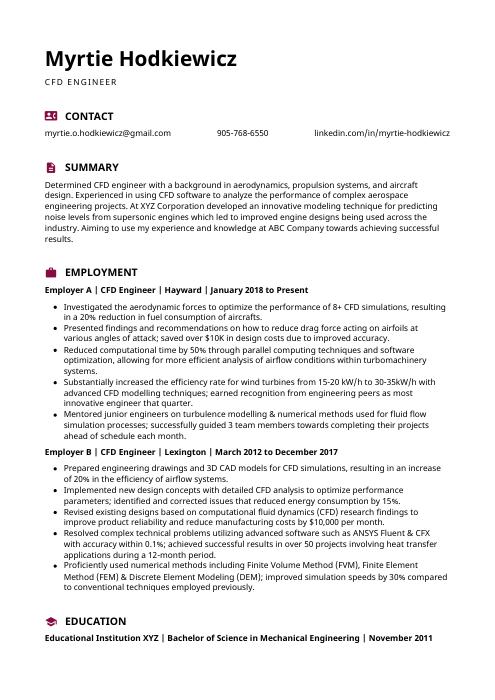 Hoopoe
Hoopoe Rezjumei
Rezjumei
